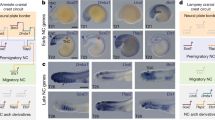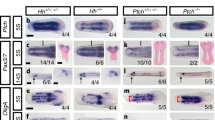Abstract
THE branchial region of the vertebrate head forms through complex interactions involving rhombomeric segments, neural crest and branchial arches1. It is thought that aspects of their patterning mechanisms are linked2 and involve Hox-2 genes, whose overlapping and spatially restricted expression domains represent a combinatorial code for generating regional diversity3–5. Vertebrates possess four Hox clusters of Antennapedia class homeobox genes, related to each other by duplication and divergence from a common ancestral complex3,6–8. In consequence, at equivalent positions in different clusters there are highly related genes known as subfamilies or paralogous groups. As Hox-2 genes cannot fully account for patterning individual rhombomeres, we investigated whether offsets in expression limits of paralogous genes could account for the generation of regional diversity. We report here that, with the exception of the labial subfamily, paralogues show identical expression limits in rhombomeres, cranial ganglia and branchial arches, providing a combinatorial Hox code for the branchial region that seems to be different in organization to that of the trunk.
This is a preview of subscription content, access via your institution
Access options
Subscribe to this journal
Receive 51 print issues and online access
$199.00 per year
only $3.90 per issue
Buy this article
- Purchase on Springer Link
- Instant access to full article PDF
Prices may be subject to local taxes which are calculated during checkout
Similar content being viewed by others
References
Noden, D. Development 103 (suppl.), 121–140 (1988).
Lumsden, A. Trends Neurosci. 13, 329–335 (1990).
Graham, A., Papalopulu, N. & Krumlauf, R. Cell 57, 367–378 (1989).
Wilkinson, D. et al. Nature 341, 405–409 (1989).
Hunt, P., Wilkinson, D. & Krumlauf, R. Development 112, 43–51 (1991).
Duboule, D. & Dolle, P. EMBO J. 8, 1497–1505 (1989).
Kessel, M. & Gruss, P. Science 249, 374–379 (1990).
Boncinelli, E. et al. Trends Genet. 7, 329–334 (1991).
Murphy, P., Davidson, D. & Hill, R. Nature 341, 156–159 (1989).
Frohman, M., Boyle, M. & Martin, G. Development 110, 589–607 (1990).
Murphy, P. & Hill, R. Development 111, 61–74 (1991).
Sundin, O. & Eichele, G. Genes Dev. 4, 1267–1276 (1990).
Featherstone, M. S. et al. Proc. natn. Acad. Sci. U.S.A. 85, 4760–4764 (1988).
Graham, A. et al. Genes Dev. 2, 1424–1438 (1988).
Gaunt, S. J., Krumlauf, R. & Duboule, D. Development. 107, 131–141 (1989).
Graham, A., Maden, M. & Krumlauf, R. Development 112, 255–264 (1991).
Lumsden, A., Sprawson, N. & Graham, A. Development (in the press).
Lumsden, A. in Seminars in Developmental Biology, The Evolution of Segmental Patterns Vol. 1 (ed. Stern, C.) 117–125 (Saunders, Philadelphia. 1990).
Hunt, P. et al. Development 112, (suppl.) 187–196 (1991).
Dolle, P., et al. Nature 342, 767–772 (1989).
Izpisua-Belmonte, J.-C. et al. Nature 350, 585–589 (1991).
Nohno, T. et al. Cell 64, 1197–1205 (1991).
Kessel, M. & Gruss, P. Cell 67, 89–104 (1991).
Kessel, M., Balling, R. & Gruss, P. Cell 61, 301–308 (1990).
Chisaka, O. & Capecchi, M. Nature 350, 473–479 (1991).
Lufkin, T. et al. Cell 66, 1105–1119 (1991).
Gaunt, S. J. Development 101, 51–60 (1987).
Thorogood, P. Development 103, 141–153 (1988).
Holland, P. in Seminars in Developmental Biology, The Evolution of Segmental Patterns Vol. 1 (ed. Stern, C.) 135–145 (Saunders, Philadelphia, 1990).
McMahon, A. & Bradley, A. Cell 62, 1073–1085 (1990).
Dolle, P. et al. Development 110, 1133–1151 (1990).
Price, M. et al. Nature 351, 748–751 (1991).
Cohen, S. & Jurgens, G. Nature 346, 482–485 (1990).
Finkelstein, R. & Perrimon, N. Nature 346, 485–488 (1990).
Wilkinson, D. & Green, J. in Postimplantation Mouse Embryos: A Practical Approach (eds Rickwood, D. & Cockcroft, D. L.) 155–171 (IRL, Oxford, 1990).
Gaunt, S. J. Development 103, 135–144 (1988).
Duboule, D. et al. EMBO J. 5, 1973–1980 (1986).
Frohman, M. & Martin, G. Technique 1, 165–170 (1989).
Simeone, A. et al. Mech. Dev. 33, 215–227 (1991).
Author information
Authors and Affiliations
Rights and permissions
About this article
Cite this article
Hunt, P., Gulisano, M., Cook, M. et al. A distinct Hox code for the branchial region of the vertebrate head. Nature 353, 861–864 (1991). https://doi.org/10.1038/353861a0
Received:
Accepted:
Issue Date:
DOI: https://doi.org/10.1038/353861a0
This article is cited by
-
A multiple super-enhancer region establishes inter-TAD interactions and controls Hoxa function in cranial neural crest
Nature Communications (2023)
-
microRNA-875-5p plays critical role for mesenchymal condensation in epithelial-mesenchymal interaction during tooth development
Scientific Reports (2020)
-
HOX gene cluster (de)regulation in brain: from neurodevelopment to malignant glial tumours
Cellular and Molecular Life Sciences (2020)
-
Molecular and cellular mechanisms underlying the evolution of form and function in the amniote jaw
EvoDevo (2019)
-
Transcriptome profiling reveals expression signatures of cranial neural crest cells arising from different axial levels
BMC Developmental Biology (2017)
Comments
By submitting a comment you agree to abide by our Terms and Community Guidelines. If you find something abusive or that does not comply with our terms or guidelines please flag it as inappropriate.



